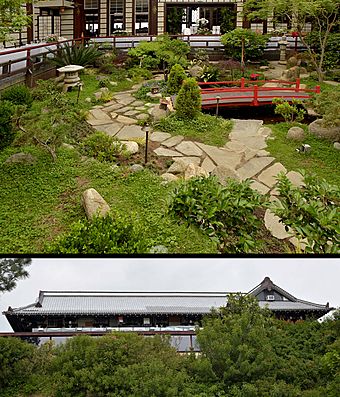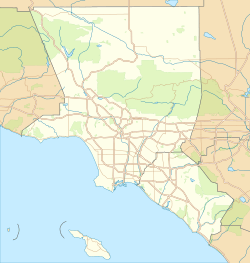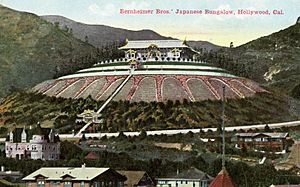Yamashiro Historic District facts for kids
The Yamashiro Historic District is a special place located on Sycamore Avenue in the Hollywood Hills area of Los Angeles, California.
The main building, a beautiful villa, was built between 1911 and 1914. Japanese artists and builders created it for two brothers, Charles and Adolph Bernheimer. They were German-American and wanted a place to keep their large collection of Japanese art and other valuable items. The building was named Yamashiro Hollywood, but it was also known as the Bernheimer Villa and Oriental Gardens. Since it sat on top of a hill, it was called a yamashiro, which is a Japanese word meaning "mountain castle" (山城). The district includes the main villa, some smaller buildings (though many are gone now), and lovely gardens. This whole area was added to the National Register of Historic Places in 2012 because of its importance.
Today, the villa is home to a popular Asian restaurant.
Contents
A Castle in Hollywood: History
The Bernheimer brothers spent a lot of money, about $2 million, to build this amazing place for their Japanese antiques. However, most of their art collection was sold off in the early 1920s. This time was known as the Roaring Twenties, a period of fun and excitement. During these years, the Yamashiro Hollywood became very popular. It was a favorite spot for the most famous people in the movie industry, known as the 400 Club.
Unfortunately, its fame did not last long. The Great Depression hit at the end of the 1920s, causing a big economic crash. This forced the brothers to open the villa to the public, offering tours to earn money. Later, during World War II, after the United States was attacked at Pearl Harbor, feelings against Japan grew strong. Many Americans thought the Yamashiro building was a Japanese signal tower and damaged it. To protect its unique design from more attacks, the building was disguised. It became a boys' military school and then an apartment complex after the war ended.
In 1948, a man named Thomas O. Glover bought the property. He first planned to turn it into a hotel and modern apartments. But when he saw the beautiful carved wood and silk wallpaper inside, he changed his mind. He decided to bring the Yamashiro back to its original Japanese style. Thomas and his son, Thomas Y. Glover, then started the Yamashiro Restaurant. They used the many rooms in the estate to serve up to 500 guests. Besides the restaurant, they also opened a Pagoda Bar and a seasonal Farmers Market. The goal was to keep Japanese culture and history alive through their food and the amazing views of the Los Angeles skyline.
Yamashiro on Screen: Filming Location
The Yamashiro building has been a star itself, appearing in many movies and TV shows! Its unique look makes it a perfect background for different stories.
Movies Filmed at Yamashiro
You might have seen it in these films:
- Breezy (1973)
- Blind Date (1987)
- Gone in 60 Seconds (2000)
- Kill Bill (2003)
- Memoirs of a Geisha (2005)
- Nocturnal Animals (2016)
- Playing God (1997)
- The Teahouse of the August Moon (1956)
- Sayonara (1957)
- The Vermilion Pencil (1922)
TV Shows and Events
It also appeared in many television shows from the 1950s and 1960s, including:
- My Three Sons
- I Spy (either the 1955 or 1965 series)
- Route 66
- Perry Mason
Beyond movies and TV, Yamashiro has hosted many exciting events. It has been the setting for Hollywood movie premieres like Rush Hour, Third Rock from the Sun, and Lethal Weapon 4. It's also a popular spot for formal events, parties, commercials, and photoshoots.




